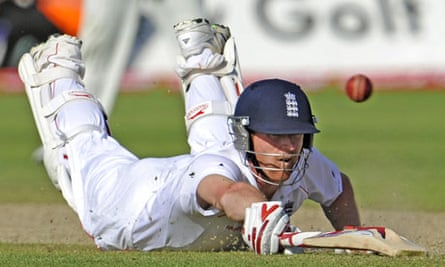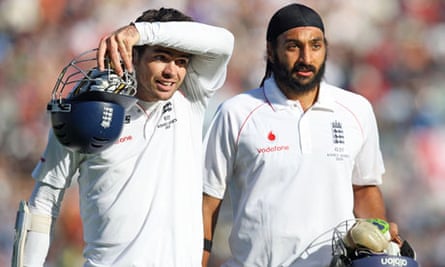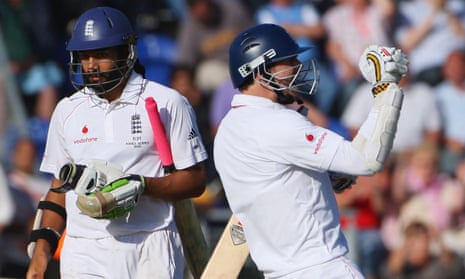It is to Britain’s martial and imperial past that the metaphors for a home team’s defiance of overwhelming odds still habitually turn when honour, even in retreat, is salvaged from a seemingly inevitable ignominious fate. Dunkirk and its fabled spirit, a cornered belligerence and breezy fortitude in the face of imminent catastrophe, is the most common analogy but for England’s draw with Australia in the opening match of the 2009 Ashes series, something more symbolically Welsh was required to commemorate Cardiff and the country’s first ever Test.
For the generations brought up on the annual televised screening of the 1964 film Zulu, the Battle of Rorke’s Drift and specifically the poignant if apocryphal singing of Men of Harlech by a hopelessly outnumbered company of the 24th Regiment of Foot valiantly defending their position and lives against 4,000 warriors, suggested the obvious soundtrack to the highlight reels of Sunday at the Swalec Stadium.
It was a day of relief rather than exhilaration for England, of exasperation for Australia rather than demoralisation. And for all the talk of heroism and miracles, the improbable draw represented something more significant for its principal architect, Paul Collingwood – an exorcism of the ghosts of Adelaide 30 months on from the Test that had re-established Australia’s swaggering dominance and aroused England’s old uncertainties.
At the Adelaide Oval on 5 December 2006 Collingwood had survived 119 balls in the second innings to remain unbeaten on 22 as all around him his team-mates surrendered the advantage he had built with his first-innings double century in a 310-run partnership with Kevin Pietersen.

The abiding image of him when England were bowled out for 129 was straight out of Casabianca: “The boy stood on the burning deck, whence all but he had fled.” When Australia insouciantly knocked off their target of 168 from 36 overs with 19 balls to spare to win by six wickets it deflated Collingwood so much that, he admitted this year, he had never yet revisited his finest innings.
From 2-0 down, England quickly capitulated to their first 5-0 defeat for 85 years and while Australia celebrated their revenge by kicking the crap out of the corpse of English cricket to banish their own demons from 2005, the coach, Duncan Fletcher, and the chairman of selectors, David Graveney, paid for the humiliation with their jobs.
For too long from the end of the 2005 series until the home defeat by South Africa in 2008 there seemed to be a sense of yearning for the 11 MBEs and one OBE who had restored England’s pride and won the Ashes back, part pining for kings over the water, part a sentimental desire to put the old gang back together for one last job. But by the start of the first Test of the 2009 series that hope was forlorn. Only four of the dozen remained: Andrew Strauss, now the captain, Collingwood, and two who were carrying such chronic leg injuries, Pietersen and Andrew Flintoff, that they could have rivalled Mr Spigot’s chances of landing the role of Tarzan. Illness had ended Marcus Trescothick’s international career, injury forced Ashley Giles into retirement and continued to ruin Simon Jones’s hopes of a Test comeback, Michael Vaughan’s restricted movement, pain and loss of form had destroyed his imperturbable authority while Ian Bell, Geraint Jones, Matthew Hoggard and Steve Harmison had all been dropped for apparently ineradicable inconsistency.
Australia’s losses were greater still – Matthew Hayden, Justin Langer, Damien Martyn, Adam Gilchrist, Shane Warne and Glenn McGrath had put away the Baggy Green – but their rebuilding programme looked to be further advanced. Having been defeated at home by South Africa 2-1 at the end of 2008 they fought back instantly to win 2-1 away with Phillip Hughes scoring 415 runs and Mitchell Johnson taking 16 wickets, performances that gave rise to more hype than considered analysis. Still, seeing that England had been skittled for 51 by West Indies to lose by an innings in Jamaica in February, then failed to prise the hosts’ fingers off the Wisden Trophy as they clung on by their fingernails for draws at St John’s and Port of Spain, it was logical that Australia were marginal favourites.
Australia suspected Cardiff had been chosen specifically to host the first Test because of its historically dry wicket. In any of the four previous home Ashes series such a flagrantly spin-friendly surface would have been suicidal – unwittingly so in 1993 before Warne’s brilliance announced itself in the most enchanting and uplifting fashion, negligently so thereafter. But after 16 years of unavoidable humility, England were so confident of spinning dominance they picked Graeme Swann, who had taken 34 wickets in his first seven Tests, together with the man he had usurped, the popular but diffident Monty Panesar. Their boldness in picking both was seemingly rewarded when Ricky Ponting lost the toss, allowing Strauss to bat first and the prospect of deploying his plan of spin at each end on a crumbly, treacherous fourth-innings pitch. England, however, never got that far.

Briskly and occasionally distractedly parp-parping along at four an over England were all out for 435 shortly after noon on the second day, the last three wickets thrashing 99 off Australia’s leg-weary bowlers in 70 minutes. Collingwood and Pietersen had added 138 on the Wednesday but wickets were squandered to adrenaline-fuelled shots and firm hands rather than exemplary bowling. The score, which would have been the fruit of England fantasies during the majority of recent Ashes series, looked adequate but proved misleadingly so. The game has three main elements – runs and wickets, obviously, but the third, time, is often as telling. To bat for merely three and a half sessions on a pitch that was more like Trinidad than Trent Bridge hands the initiative and the invitation for occupation to the opposition.
It was one Australia, apparently as ruthless as ever, accepted. England had anticipated and accommodated for trying to bowl Australia out twice without the help of steep bounce. They had not expected to have to do it with a wicket and climate that neutered swing, seam and, most dishearteningly of all, sharp turn. Australia batted for more than 12 hours plus rain breaks to score 674 largely patient runs with centuries from Simon Katich, Ponting, Marcus North and Brad Haddin before declaring after a flourish with the black clouds gathering literally and figuratively over Wales two overs after drinks on Saturday afternoon, 239 runs ahead.
Rain was imminent but 30 minutes’ play was possible with the floodlights on before the storm broke and, as so often, the side who had been made to labour in the field for days on a dead pitch suddenly find themselves under bombardment just when they are at their most exhausted and browbeaten by criticism.
When the rain came on the brink of tea, England were 20 for two, the moisture having given the pitch some zip, the purple clouds doing the same for Ben Hilfenhaus’s swing and the umpire Billy Doctrove ruling Ravi Bopara lbw when the ball was clearly going over the top of the stumps. The rain persisted beyond the scheduled close but the forecast for Sunday predicted a full day’s play. “Bloody Wales,” thought those with wistful memories of Welsh holidays. “It rains when you don’t want it to and never does when you do.”
England sent Collingwood out as an Aunt Sally for the disconsolate that evening. “We’ve got to put our hands up,” he said. It was ambiguously phrased and could be interpreted as an injunction not to shirk the blame for the likely defeat. Wags suggested that he really meant it as the ultimate symbol of surrender but, however ridiculously optimistic it sounded on that gloomy Saturday night in Cardiff, it was intended as a call to his colleagues to shoulder the responsibility to save the game.
By lunch England were 70 for five, Strauss, Pietersen (hamming up his cautiousness by playing no shot at a ball he expected to swing and losing his off-stump when it didn’t after being excoriated for his reckless shot in the first innings) and Matt Prior joining Alastair Cook and Bopara back in the hutch. Saturday night optimism had mutated into Sunday morning delusion.
Collingwood, on 35, had been given a life when Katich at bat-pad could not hang on to a firm, low squirt to his weaker right hand. Where Swann and Panesar had failed to find the fizz to unnerve top-order batsmen, Australia’s lead allowed Nathan Hauritz to bowl without inhibition and with four close fielders around the bat. Collingwood countered by playing him almost entirely off the back foot, his soft hands and apparently vegetarian bat angled precisely and perfectly to kill the ball like Sunil Gavaskar on a Delhi dustbowl. Occasionally he flicked the ball through midwicket with his bottom hand dominant or prodded and deflected, only breaking up his nurdling to swat legside fours when North and Hauritz blundered on length. He ran busily, the equivalent when 169 behind with five wickets left and the other side still to bat again of using a potato peeler to fend off Zorro, but at least it emphasised his pluck. At the other end Flintoff, four years on from his final Test century and the rampaging swagger all but extinct from his batting, dug in.
Because of Saturday’s rain the afternoon session was split into three 50-minute chunks, Collingwood spending 10 overs of the first one scoreless and adding only a single before drinks. Flintoff, equally watchful apart from a smeared and snicked pair of fours off Hilfenhaus, fell to the first ball he faced after the mini-break fending a daisy-cutter of a chance to Ponting at second slip who must have grazed his fingers to get them under the ball. The partnership had put on 55.
Broad then survived for an hour, making 14 after escaping a raucous first-ball lbw shout, bristling with determination but giving a glimpse of the tension by worrying away at the fabric of his gloves and tinkering with his grip. Hauritz trapped him in front with a quicker ball after Siddle had done the heavy lifting with one of those effortful spells with the old ball that capture captains’ hearts. Even with Broad gone Siddle kept banging it in, forcing Collingwood on to his toes but allowing him to take singles then softening Swann up with blows to his fingers, head and elbow. The off-spinner was battered and used the opportunity to play it for all it was worth, twice summoning the locum physio Steve McCaig and his spray, but made it to tea and 16 overs beyond it having been persuaded by Flintoff during the interval to use his bat rather than his body as his first line of defence. The eighth-wicket stand posted 62 until Swann, beguiled by the new ball and expecting bounce, went for a pull shot, missed the ball which died on him and hit his pads plumb in front.
England were 18 behind with 18 overs left. Eighteen overs for Collingwood and the side’s designated nightwatchman Jimmy Anderson to see it through for surely no one expected the No11 Panesar, not only England’s worst batsman but arguably the worst in Test cricket, to be much help? Collingwood scrapped away for seven more overs until he sliced a cover drive off Hauritz to Michael Clarke at gully. He looked like a fastidious DIYer who had labelled every screw and followed the instructions to build a wardrobe meticulously only for a capricious urge to seduce him into thinking a quick tap of the hammer might hurry the job along with predictably disastrous consequences. By every standard bar his own it was a superb innings but he left distraught, certain that his net pupil Panesar and Anderson could not finish the job.
England were now six runs behind with play scheduled to end at 6.50pm or the completion of 98 overs, whichever was the later, or 96 overs and 6.40pm should they get ahead and survive till then and the change of innings devour 10 minutes. Not that anyone seemed to know that at the time. Should they watch the overs? Should they watch the clock? It was immaterial. Most spectators who dared to look at anything were doing so through their fingers.
But, incredibly, Panesar and Anderson stayed put, blocking, whittling away at the deficit, fist-pumping after almost every delivery and inciting Ponting’s wrath when McCaig and the 12th man, Bilal Shafayat, intervened on increasingly spurious pretexts. Australia began to look rattled, more so when Anderson hit Siddle for two fours finally to put England in front and spirit away those 10 minutes. There were two vociferous appeals for lbw but Panesar and Anderson continued to get in line and were remarkably judicious in leaving anything they did not have to play. Disbelief brought levity to the batsmen and the crowd as the partnership soldiered on, each ball survived – whether they scored from it, smothered it or left it – eliciting cheers. At 6.41pm, at the end of Hauritz’s 37th over, Australia ran out of time with the 10th-wicket partnership unbroken after 69 balls.
After a few moments of hysteria, relief trumped ecstasy. At Adelaide, Collingwood had been the victim of Australia’s larceny. Here English cricket’s everyman, the one the average cricket lover most identified themselves with, again refused to yield for hours while he manned the defences. This time he had some support and his bashful smile at the end of the game was a perfect moment of atonement.

Comments (…)
Sign in or create your Guardian account to join the discussion